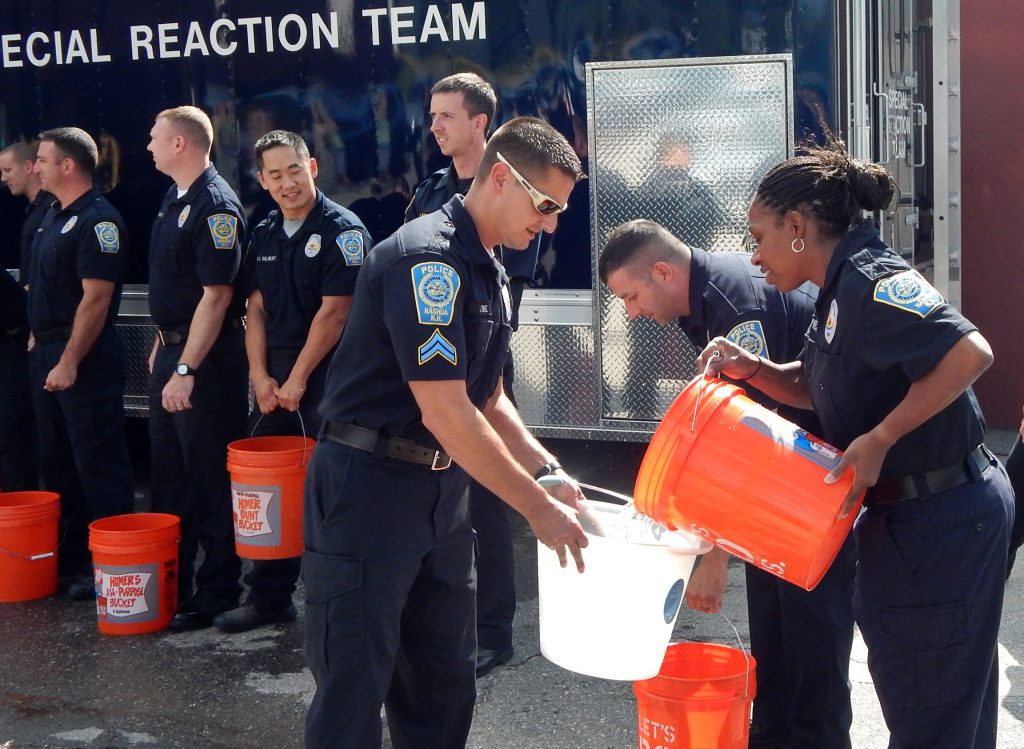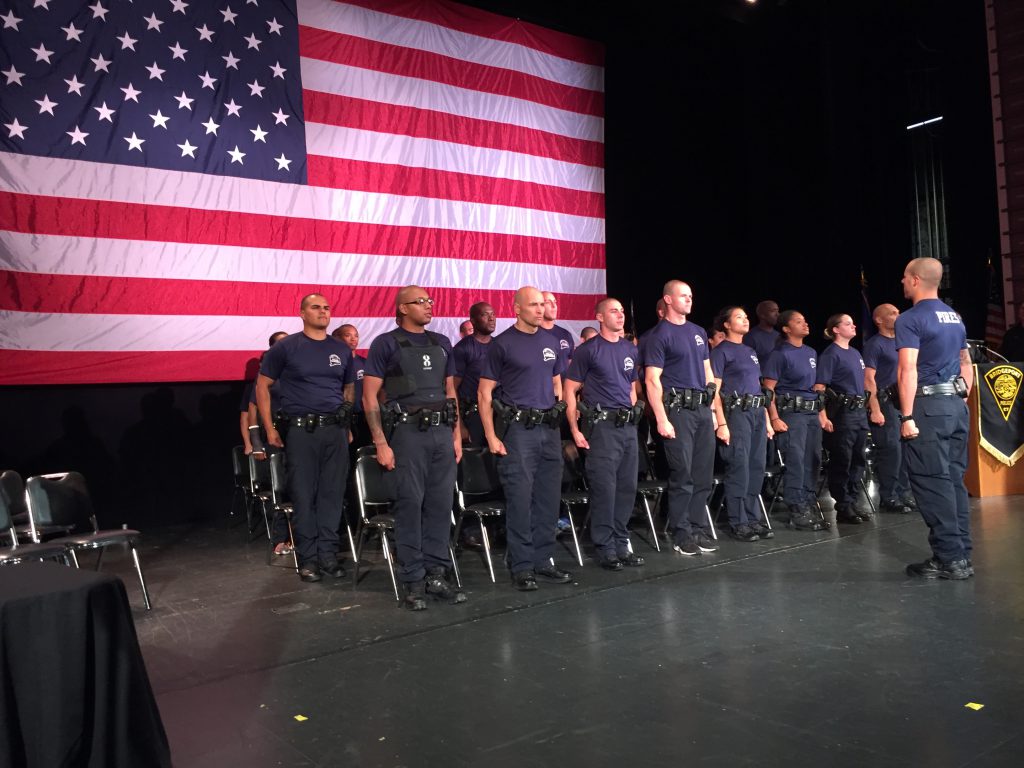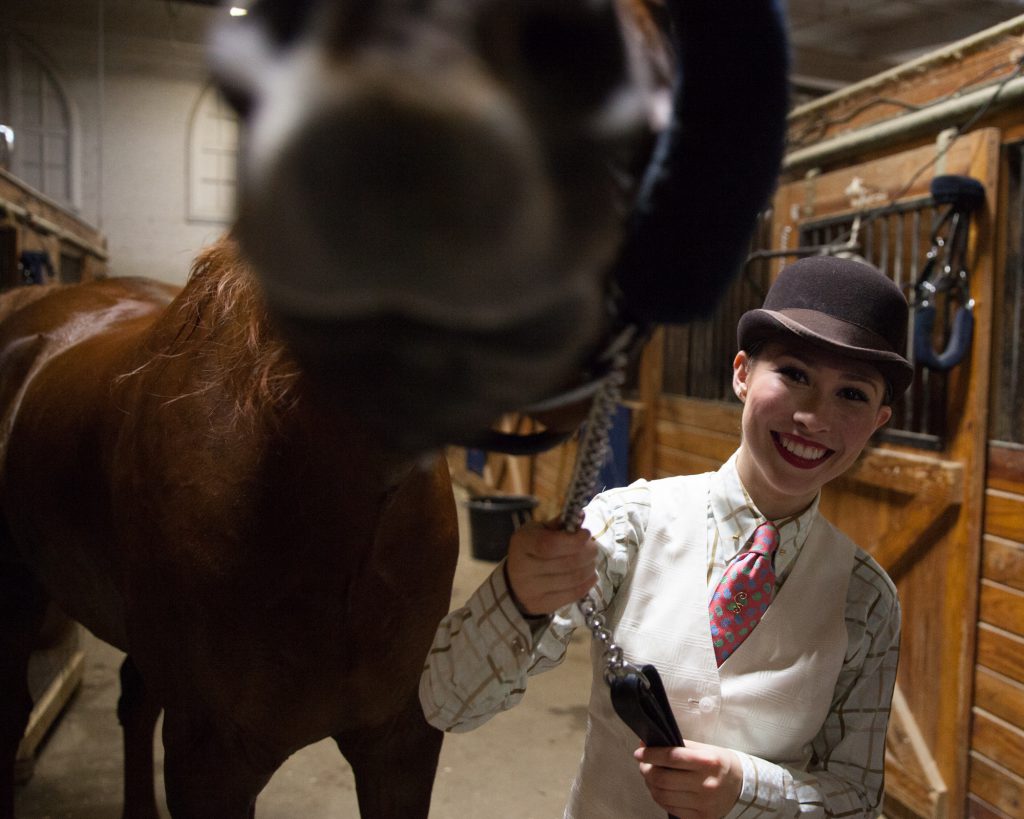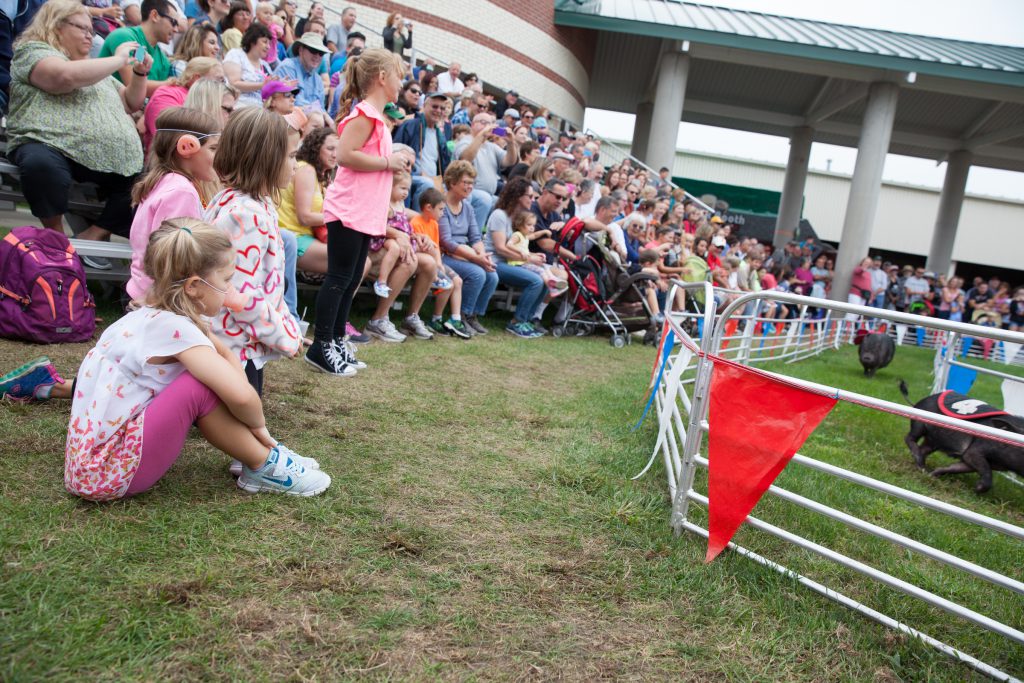Episode 9: Looks Like Home


Sergeant Lakeisha Phelps and colleagues at the Nashua, NH police department participate in an ice-bucket challenge to raise awareness for ALS, in August, 2014. Phelps is one of two black police officers in a force of 170. (Credit: Dean Shalhoup/ Nashua Telegraph)
This week, we bring you more stories about policing and race in four New England states. The top court in Massachusetts has ruled that fleeing from police might be legal as well as in the best interests of black men in Boston. Bridgeport, Connecticut looks to remake its police force more in the image of its population. And in Nashua, New Hampshire, a black officer deals with her own feelings about police shootings; and a young Latino man, who used to be in a Providence gang, befriends a white city police officer.
We also travel to The Big E, a massive agricultural fair that draws people from all over the region to argue over what kind of lobster roll is the best. Plus, our favorite science reporter refreshes us on the science behind fall foliage.
“They Look Like You, They Talk Like You”
When Jimmy Warren was approached by Boston police officers on the street in December, 2011, he ran. Later, he was arrested and searched. Warren had no contraband on him, but police found an unlicensed gun in a nearby yard. Warren was charged with unlawful possession of a firearm, and convicted.
But last week, the highest court in Massachusetts overturned the conviction. The justices said Warren running from the police should not have been used as a basis for suspicion, citing reports by the Boston Police Department and the ACLU of Massachusetts that found a pattern of discrimination against black men by the force.
WBUR digital reporter Zeninjor Enwemeka has been covering the ruling – which she says has broader implications – and joins us on NEXT.

Cadets from the Bridgeport, Connecticut police academy practice for their graduation ceremony, earlier this month. (Credit: Jeff Cohen/ WNPR)
In Bridgeport, Connecticut, where more than 60 percent of residents identify as black or Hispanic, the city is making an effort to enroll new officers who live in town. It’s an attempt to make a police force that looks more like the city it serves. We’re joined again by WNPR reporter Jeff Cohen, who covers race and policing in Connecticut. (If you missed our first segment with Jeff on race-based traffic stops, be sure to check it out here.)
“I Stick Out Like A Sore Thumb”
In Episode 5, reporter Emily Corwin of New Hampshire Public Radio brought us her investigation into the criminal justice system in Hillsborough County, New Hampshire. It’s the state’s most populous and most diverse county in what is an overwhelmingly white state. She found that blacks are six times more likely to be in jail than whites.
There’s a disparity in the police force, too. In the city of Nashua, there are only two black officers in a police force of 170. This week, Emily introduces us to one of those officers, Sergeant Lakeisha Phelps.

Jose Jose Rodriguez (L) stands with Providence Police Officer Dean Isabella. (Credit: John Bender: RIPR)
Dean Isabella and Jose Rodriguez grew up on the western edge of Providence, several decades apart. The area has long dealt with high crime rates. Isabella now works there as a city police officer. That’s how he met Rodriguez, a teenager in the neighborhood who was also an active gang member.
Years later, their paths crossed again when Rodriguez began working to stop gang violence with the Institute for the Study and Practice of Non-Violence. Isabella and Rodriguez describe how a kid from the neighborhood and a cop became close friends as part of Rhode Island Public Radio’s series “Speaking Across Difference.”
Pleasure Horses, Lobster Rolls, and State Pride at The Big E

Rider Jillian Silva introduces her horse, Indy, to the camera after winning a park horse competition. (Credit: Ryan King/ WNPR)
The Eastern States Exposition – better known as The Big E – is a massive fair that runs for two weeks in the fall in West Springfield, Massachusetts. This is The Big E’s centennial year.
The exposition was the brainchild of Joshua L. Brooks, a printer from Springfield, who also operated a farm. At the time, even as industry was booming in New England, farming was in decline – local farmers couldn’t compete with the farms out in the fertile land of the Midwest.

Pig racing at The Big E. (Credit: Ryan King/ WNPR)
Brooks’s idea was to start an event that would showcase new farming methods and technology, and establish competitive awards that would motivate farmers to produce more efficiently. Brooks got a group of businessmen together, they purchased some land in Springfield. And they convinced the National Dairy Association, which was headquartered in Chicago, to have their exhibition here instead of the Midwest.
The dairy show was held in September 1916, and by the next year, Brooks had the agricultural showcase that he envisioned.

A woman selling lobster rolls in the Maine building says Maine lobster rolls are better than the Connecticut kind. Host John Dankosky disagrees. (Credit: Ryan King/WNPR)
Today, The Big E features many attractions familiar to country fairs. There are still livestock competitions, and of course, lots of greasy fair food. But it’s also a uniquely pan-New England event. On the grounds, six permanent buildings showcase the goods, cuisines, attractions and quirks of each state in our region. As a show about New England, the state buildings were what drew us to the fair — and they did not disappoint.
There was so much to see and do at The Big E, we couldn’t possibly take it all in. For a preview, check out this video by the wonderful Ryan Caron King.
About NEXT
NEXT is produced at WNPR.
Host: John Dankosky
Producer: Andrea Muraskin
Executive Producer: Catie Talarski
Digital Content Manager/Editor: Heather Brandon
Contributors to this episode: Jeff Cohen, Patrick Skahill
Music: Todd Merrell, “New England” by Goodnight Blue Moon
We appreciate your feedback! Send praise, critique, suggestions, questions, story leads, and ideas for your state’s new motto to next@wnpr.org.
